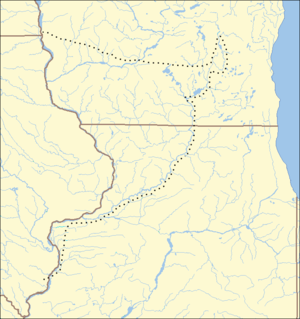Attack
On May 21, 1832, a small raiding party made up of some independent minded braves from Keokuk's village or the Fox village at Dubuque's Mines carried out a raid on the settlement at present-day Savanna, Illinois on the Plum River. [3] [4] The party originated west of the Mississippi River and were probably motivated by a desire to collect needed supplies. When the small raiding party arrived at the settlement they found it practically deserted: only three men were present. [4] Of the six men originally at the settlement, three had left when the raiding party arrived: Blundell was away, Upton was hunting nearby, and Davidson had left the area in search of a horse. Of the three men left at the settlement, Hays and Goss were trying to round up livestock, while only Pierce remained at the blockhouse. [3] Pierce heard a dog barking outside and looked up to see a small band of Native Americans creeping along the river's edge. He immediately sounded the alarm and Hays and Goss sprinted for the blockhouse. [3] Gunshots started to explode behind the men as they approached the protection of their makeshift fortification.
Goss darted inside, but Hays slipped and fell before he could enter the blockhouse. As he fell, three musket balls lodged themselves into the wall where he had been standing moments before. While the attackers reloaded, Hays slipped inside and for about an hour an exchange of heavy gunfire erupted between the parties before the attackers withdrew. [3] [5] A fourth man, Upton, was out hunting nearby; when he was discovered by the attackers he was chased throughout the afternoon. [4] Upton escaped the attackers injury-free. In fact, no person was killed or injured during the Plum River raid. The small raiding party escaped with three horses, but two horses were badly wounded by gunfire, and the other shot dead by the settlement's defenders. [4]

The Black Hawk War was a conflict between the United States and Native Americans led by Black Hawk, a Sauk leader. The war erupted after Black Hawk and a group of Sauks, Meskwakis (Fox), and Kickapoos, known as the "British Band", crossed the Mississippi River, to the U.S. state of Illinois, from Iowa Indian Territory in April 1832. Black Hawk's motives were ambiguous, but he was apparently hoping to reclaim land that was taken over by the United States in the disputed 1804 Treaty of St. Louis.

The Bad Axe Massacre was a massacre of Sauk (Sac) and Meskwaki (Fox) Native Americans by United States Army regulars and militia that occurred on August 1–2, 1832. This final scene of the Black Hawk War took place near present-day Victory, Wisconsin, in the United States. It marked the end of the war between white settlers and militia in Illinois and Michigan Territory, and the Sauk and Fox tribes under warrior Black Hawk.

The Battle of Stillman's Run, also known as the Battle of Sycamore Creek or the Battle of Old Man's Creek, occurred in Illinois on May 14, 1832. The battle was named for the panicked retreat by Major Isaiah Stillman and his detachment of 275 Illinois militia after being attacked by an unknown number of Sauk warriors of Black Hawk's British Band. The numbers of warriors has been estimated at as few as fifty but as many as two hundred participated in the attack. However, reports found in Whitney's Black Hawk War indicated that large numbers of Indians were on the move throughout the region, and it appeared that widespread frontier warfare was underway. The engagement was the first battle of the Black Hawk War (1832), which developed after Black Hawk crossed the Mississippi River from Iowa into Illinois with his band of Sauk and Fox warriors along with women, children, and elders to try to resettle in Illinois. The militia had pursued a small group of Sauk scouts to the main British Band camp following a failed attempt by Black Hawk's emissaries to negotiate a truce.
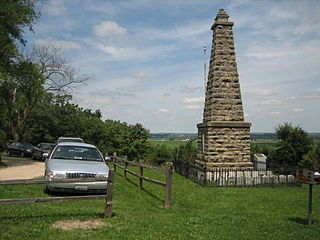
The Battle of Kellogg's Grove is either of two minor battles, or skirmishes, fought during the Black Hawk War in the U.S. state of Illinois, in present-day Stephenson County at and near Kellogg's Grove. In the first skirmish, also known as the Battle of Burr Oak Grove, on June 16, 1832, Illinois militia forces fought against a band of at least 80 Native Americans. During the battle, three militia men under the command of Adam W. Snyder were killed in action. The second battle occurred nine days later when a larger Sauk and Fox band, under the command of Black Hawk, attacked Major John Dement's detachment and killed five militia men.

The Buffalo Grove ambush was an ambush that occurred on May 19, 1832 as part of the Black Hawk War. A six-man detail carrying dispatches from United States Colonel James M. Strode at Galena, Illinois to General Henry Atkinson at Dixon's Ferry was ambushed by Native Americans during the attack. William Durley was killed and buried near the site of the ambush. Durley's remains were initially interred by the party that would become victims of the St. Vrain massacre. Two other men had bullet holes in their clothing, but were uninjured. In 1910 the Polo Historical Society moved Durley's remains to a plot beneath a memorial they erected west of Polo, Illinois.
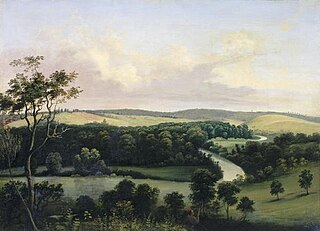
The Battle of Horseshoe Bend, also referred to as the Battle of Pecatonica and the Battle of Bloody Lake, was fought on June 16, 1832, in present-day Wisconsin at an oxbow lake known as "Horseshoe Bend", which was formed by a change in course of the Pecatonica River. The battle was a major turning point in the Black Hawk War, despite being of only minor military significance. The small victory won by the U.S. militia at Horseshoe Bend helped restore public confidence in the volunteer force following an embarrassing defeat at Stillman's Run. The Battle of Horseshoe Bend ended with three militia men killed in action and a party of eleven Kickapoo warriors dead.

The Spafford Farm massacre, also referred to as the Wayne massacre, was an attack upon U.S. militia and civilians that occurred as part of the Black Hawk War near present-day South Wayne, Wisconsin. Spafford Farm was settled in 1830 by Omri Spafford and his partner Francis Spencer.
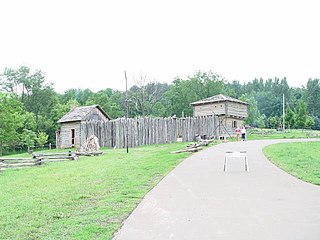
The Battle of Apple River Fort, occurred on the late afternoon of June 24, 1832 at the Apple River Fort, near present-day Elizabeth, Illinois, when Black Hawk and 200 of his "British Band" of Sauk and Fox were surprised by a group of four messengers en route from Galena, Illinois. One of the couriers was wounded in the thigh as the riders quickly made for the protection of the nearby stockade. Courier Fred Dixon lagged behind and provided cover for his comrades. The other couriers rode ahead to warn some 70 settlers of the approaching Sauk and Fox, thus saving their lives. The small company of militia at the fort, about 28-30 men and boys led by Captain Clack Stone, fought off Black Hawk's 150-man war party in an action that lasted about an hour. The withering pace of the gunfire eventually convinced Black Hawk that the fort was too heavily defended to lead a direct attack. He considered burning the fort, then switched to raiding cabins of foodstuffs, clothing and cooking utensils. In the gathering darkness, Black Hawk and his war party retreated.

The Battle of Wisconsin Heights was the penultimate engagement of the 1832 Black Hawk War, fought between the United States state militia and allies, and the Sauk and Fox tribes, led by Black Hawk. The battle took place in what is now Dane County, near present-day Sauk City, Wisconsin. Despite being vastly outnumbered and sustaining heavy casualties, Black Hawk's warriors managed to delay the combined government forces long enough to allow the majority of the Sauk and Fox civilians in the group to escape across the Wisconsin River. This reprieve was temporary; when the militia finally caught up with the fleeing band it resulted in the Bad Axe massacre at the mouth of the Bad Axe River.

The Battle of Waddams Grove, also known as the Battle of Yellow Creek was part of the Black Hawk War. It took place in present-day Stephenson County, Illinois on June 18, 1832. After several incidents of Sauk Indian raids on settlers along the Apple River, Captain James W. Stephenson left Galena with a group of volunteer militia in pursuit of the Native party. The group clashed on June 18, 1832 near Yellow Creek and the ensuing battle descended into a bayonet and knife fight in which several Sauk and three militia men were killed. Stephenson was severely wounded by a musketball to the chest during the fighting. The dead were eventually interred in a memorial cemetery in Kellogg's Grove, Illinois where a stone monument was erected in memory of those killed during the war.
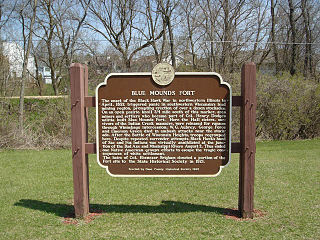
The attacks at Fort Blue Mounds were two separate incidents which occurred on June 6 and 20, 1832, as part of the Black Hawk War. In the first incident, area residents attributed the killing of a miner to a band of Ho-Chunk warriors, and concluded that more Ho-Chunk planned to join Black Hawk in his war against white settlers. The second incident occurred east of the fort as a Sauk raiding party, estimated by eyewitnesses to be as large as 100 warriors, attacked two militiamen who were investigating noises heard the night before. Two members of the militia stationed at Blue Mounds were killed in the attack, and both their bodies were badly mutilated.
The Sinsinawa Mound raid occurred on June 29, 1832, near the Sinsinawa mining settlement in Michigan Territory. This incident, part of the Black Hawk War, resulted in the deaths of two men; a third man survived by seeking cover in a nearby blockhouse. In the aftermath of the raid, Captain James W. Stephenson set out to pursue the attackers—a straggling band of Sauk Native Americans—but lost their trail at the Mississippi River. The attack occurred in the same week as other skirmishes and raids, and as a result helped contribute to the growing fear in the region. The raid caused the residents of nearby Platteville to consider fleeing their settlement.

Apple River Fort, today known as the Apple River Fort State Historic Site, was one of many frontier forts hastily completed by settlers in northern Illinois and southern Wisconsin following the onset of the 1832 Black Hawk War. Located in present-day Elizabeth, Illinois, United States, the fort at the Apple River settlement was built in less than a week. It was one of the few forts attacked during the war and the only one attacked by a band led by Black Hawk himself. At the Battle of Apple River Fort, a firefight of about an hour ensued, with Black Hawk's forces eventually withdrawing. The fort suffered one militia man killed in action, and another wounded. After the war, the fort stood until 1847, being occupied by squatters before being sold to a private property owner who dismantled the building.

James McGowan Strode (1804–1857/1860) was a militia officer and politician from the U.S. state of Illinois. He served in the Illinois militia during the Winnebago War and the Black Hawk War. Strode, originally from Tennessee, lived much of his life in Galena, Illinois. In Galena, during the Black Hawk War he was given command of the 27th Regiment of the Illinois militia and oversaw the construction of a fort in that city. Strode was involved in combat during the war at the infamous Battle of Stillman's Run. In 1835 Strode was elected to represent much of the region of Illinois north of Peoria in the Illinois State Senate.
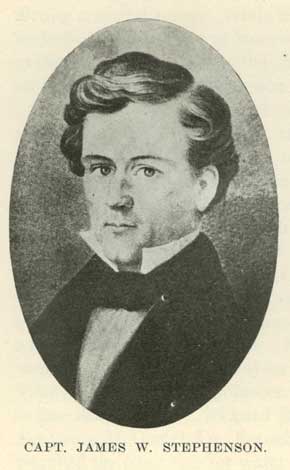
James W. Stephenson was an American militia officer and politician from the state of Illinois. He was born in Virginia but spent most of his youth in Edwardsville, Illinois. In 1825 he was indicted for the murder of a family acquaintance, but never went to trial. Upon the outbreak of the Black Hawk War in 1832, Stephenson raised a company and saw combat, suffering severe wounds at the Battle of Waddams Grove. After the war ended Stephenson entered public life, and served as a member of the Illinois State Senate in 1834. In December 1837 Stephenson was nominated as the Democratic candidate for Governor of Illinois. Within six months of his nomination, accusations of embezzlement were leveled against him, and he was forced to withdraw from the election. In August 1838, Stephenson died at home of tuberculosis.

The British Band was a mixed-nation group of Native Americans commanded by the Sauk leader Black Hawk, which fought against Illinois and Michigan Territory militias during the 1832 Black Hawk War. The band was composed of about 1,500 men, women, and children from the Sauk, Meskwaki, Fox, Kickapoo, Potawatomi, Ho-Chunk, and Ottawa nations; about 500 of that number were warriors. Black Hawk had an alliance with the British that dated from the War of 1812, giving them their colloquial name. The band crossed the Mississippi River from Iowa into Illinois in an attempt to reclaim their homeland and in violation of several treaties. Subsequently, both the Illinois and Michigan Territory militia were called up and the Black Hawk War ensued.

The Attack at Ament's Cabin was an event during the Black Hawk War that occurred on 17 or June 18, 1832. The cabin site, in present-day Bureau County, Illinois, was settled by John L. Ament and his brother in 1829, although Ament's brother was quickly bought out by Elijah Phillips. After the 1832 Black Hawk War broke out, Ament and Phillips evacuated the site but later returned to collect belongings. On the morning of 17 or 18 June, the men were attacked by a band of Potawatomi, led by Mike Girty, probably those responsible for the Indian Creek massacre in May. Phillips was killed and the other men took shelter in Ament's cabin. Soldiers from Hennepin arrived after the attack and found Phillips' badly tomahawked body where he had fallen. They set off in a short pursuit of the attackers but eventually returned to Hennepin, Illinois with Phillips' remains.
After the outbreak of the Black Hawk War, at the Battle of Stillman's Run in May 1832, there were minor attacks and skirmishes throughout the duration of the conflict. The war was fought between white settlers in Illinois and present-day Wisconsin and Sauk Chief Black Hawk. The relatively minor attacks of the war were widely dispersed and often carried out by bands of Native Americans that were unaffiliated with Black Hawk's British Band.

Warrior was a privately owned and constructed steamboat that was pressed into service by the U.S. government during the Black Hawk War to assist with military operations. Warrior was constructed and launched in 1832 at Pittsburgh, Pennsylvania by Joseph Throckmorton who also served as the vessel's captain. Once constructed the vessel traveled to St. Louis and into the war zone. Warrior played a key role in the decisive Battle of Bad Axe. Following the war the steamboat continued its service under Throckmorton along the Upper Mississippi River.
Clack Stone was the elected captain of the “Apple River“ Company, 27th Regiment Illinois Militia during the Black Hawk War of 1832. He was in charge of a company mustered into service in May 1832 from Jo Daviess County, Illinois. Stone's company manned Apple River Fort, a log stockade and blockhouse— a reconstruction of which is located on knoll just east of present-day Elizabeth Stone provided leadership during two war-related incidents. In the first event, some horses were stolen from the fort during the night of June 17, in the prelude to the June 18 action known then as “Stephenson’s Fight.” Today, the fight is erroneously known as the Battle of Waddams Grove. The second event was on the afternoon of June 24: an intense battle known as the Battle of Apple River Fort. After the war, Stone built and operated a general store and helped Redding Bennett, John D. Winters, and others survey and lay out lot lines for the proposed village of Elizabeth. He also owned and apparently operated for a time the “Eagle Saloon” in Galena. Stone laid claim to numerous land parcels located west of the present village. He remained in today's Jo Daviess County with his common law wife Delilah Hickman for several years, then moved south to Union Grove in what is now Carroll County, Illinois.
